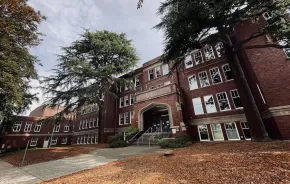
I’m a high school English teacher in the Edmonds School District. On May 10, our school celebrated staff appreciation week, which included free staff appreciation t-shirts and a sweet, student-led assembly honoring teachers. By May 15, I was laid off.
I‘ve been told that this had nothing to do with my performance — that it’s “just a numbers game" and that the layoffs of teachers were based strictly on seniority. But, make no mistake, this still feels very personal.
A different kind of broken
Why is this happening? It’s complicated. Edmonds School District has a projected $17.7 million budget shortfall. And they aren't the only district facing a sizable deficit. Much of this stems from a long-brewing battle at the state level. In 2012, Washington’s Supreme Court found that the state was not fully funding basic education in the McCleary Decision. The court ruled that local levies were being used to fund basic education. The court retained jurisdiction over the case, and the state continued to fail to meet the requirements of the ruling.
In 2015, the court held the state in contempt and began fining the state $100,000 per day. That sounds like a lot of money, but it’s a drop in the bucket when education makes up half of the state’s operating budget — tens of billions of dollars — so it seemed legislators were content to drag their feet.
The final 2017 budget and education funding deal estimated to add $7.3 billion in state dollars to K–12 basic education over the next four years (a net of $5.8 billion after reductions to local levies).
In 2018, another $1 billion was added for state funding of educator salaries for the 2018–19 school year. The court then declared the state was in compliance and ended McCleary. But, with that funding at the state level, the legislature capped local levies and restricted how they can be used, and then raised that cap level at the last minute right before the legislative session ended. Essentially, they filled the bucket to the brim — a bucket with a hole in the bottom.
In other words, this isn’t a fix: It’s just a different kind of broken.
All work and no job
On May 14 — one day before the district was required to have its certificated teaching staff under contract — Edmonds held a school board meeting. Many teachers, parents and community members showed up to protest the proposed staff cuts and to speak on behalf of teachers. Just before midnight, the school board voted to cut 25.2 full-time teaching positions, affecting 38 full-time and part-time employees. Sure, it’s better than the 45 workforce reductions that were initially reported, but the cuts are still significant.
I was one of the many teachers issued a pink slip. We didn’t even get time to process that we were out of a job. The next day, we were back in the classroom. Casey Parvin, a high school teacher in the district, forged on for her students. “I still had to teach all day. I had three full classes of kids wanting help on essays, and I stayed and helped them.”
Yes, this is personal
Teachers care. We do more than memorize 150 student names every semester — we get to know each student and their trials. We root for them. We constantly adjust our curriculum to adapt to our students’ needs. We create and nurture a community. And when the work is overwhelming and the days are long, we’re told that we matter, we’re told we’re appreciated, and that small encouragement helps us keep going. But when it’s time to renew our contracts, we’re told we’re just numbers. Then? We’re told it’s not personal.
Katie Mitchell, an English and drama teacher at Meadowdale High School explains, “I felt hurt more than anything. I have given so much of my time, energy and support to this school and community. To be RIFed (Reduction in Force) makes me feel unwanted and that my work has not been appreciated.”
Because of these cuts, our classes next year are anticipated to start at 34 students. Some administrators and para-educator positions have also been cut. The high number of English Language Learners and students with Individual Educational Plans will suffer, too. “I don’t understand how funding education isn’t a priority,” says Mariah Calkins, a parent of school-aged children and a para-educator who works in the district.
Kids take a hit
No, this isn’t just a numbers game. These cuts mean huge losses that can’t be reflected on a budget spreadsheet. They impact real communities, real families, real teachers and real kids.
So while the assembly and staff t-shirts are nice, we need to pay educators more than just lip service. Just this week, students from Meadowdale High School rallied at a school board meeting on behalf of teachers. They understand what state legislators and local voters don’t seem to: If you really care about education, you’ll fight to fully fund it for good.











